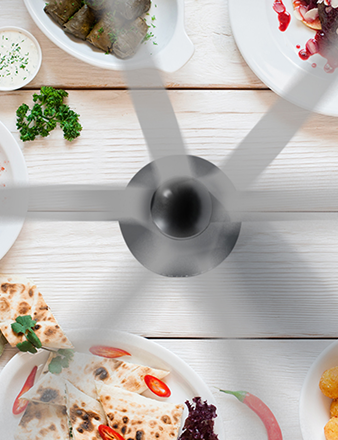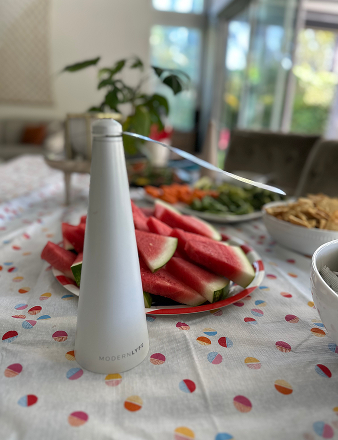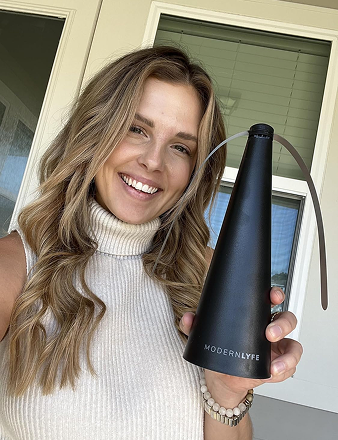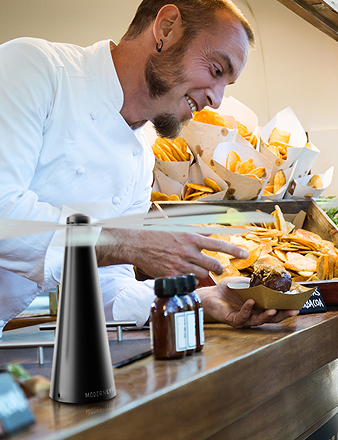You've set up the perfect outdoor meal. The food looks incredible, the drinks are cold, and then they arrive: a swarm of flies. It's a common problem, but the solution is simple, safe, and modern: fly fans for food.
These smart devices use gently spinning blades to create a chemical-free shield over your food, letting you and your guests eat in peace.
Reclaim Your Mealtime from Pests
Nothing ruins a good meal faster than swatting at flies. Besides being annoying, flies carry bacteria and contaminate food every time they land, posing a health risk. For years, the options were chemical sprays, loud zappers, or frantic hand-waving—none of which belong at a dining table.
This is where a fly fan excels. It’s a silent guardian for your food. It uses no toxic chemicals, emits no strange smells, and won't interrupt your conversation with a loud ZAP!. Instead, it uses a fly's own biology against it, creating an invisible barrier that insects avoid.

A Modern Fix for an Ancient Problem
Whether you're hosting a backyard barbecue, managing a restaurant patio, or setting up a catered event, fly fans offer an elegant and effective way to protect your food. Their benefits are clear:
- 100% Chemical-Free: A safe alternative to sprays and pesticides, making them ideal around food, kids, and pets.
- Quiet and Discreet: Most models are virtually silent. They work without becoming the center of attention.
- Highly Effective: The combination of gentle air currents and disorienting, reflective blades is more than enough to keep flies from landing.
The genius of a fly fan is its simplicity. Flies are poor aviators and struggle to fly in even the slightest breeze. The fan's blades create just enough air disturbance to disrupt their flight, forcing them to find an easier target elsewhere.
This guide covers everything you need to know about these devices. We’ll explore what they are, the science behind them, and why they're a must-have for anyone who eats outdoors. Learning how to keep flies away from food starts here, and these fans are a top-tier tool for the job.
Let's break down how this technology offers a clean, quiet, and effective way to guard your meals.
How Fly Fans Create a No-Fly Zone
Ever wonder how slow-spinning blades stop flies from landing on your food? It’s not magic—it's clever science. Fly fans for food exploit a fly's biology by targeting two of its biggest weaknesses: its hypersensitive vision and its fragile flying ability.
The fan creates a protective barrier using a two-pronged attack that turns your table into a place flies want to avoid. First, it disrupts a fly's perception. Then, it physically stops them from approaching. Here’s how it works.
Tricking a Fly’s Compound Eyes
Flies see the world differently. Their large compound eyes, made of thousands of lenses, excel at detecting motion but are easily confused.
This is where the fan blades come in. They often have reflective, holographic patterns that create a constant shimmer as they spin. To a fly's sensitive eyes, this isn't just a rotating object—it’s a chaotic visual disturbance.
Think of a fly fan as a high-tech scarecrow for insects. The constant, unnatural patterns of light and motion signal "danger," and a fly's instinct is to avoid the area rather than risk flying into something so disorienting.
This visual trick is the first line of defense. It convinces the fly that your food is in an unsafe zone, making it turn back before it even feels the breeze.
This image highlights how keeping pests away with a fly fan helps maintain food freshness and prevents spoilage.
By setting up this invisible barrier, fly fans play a surprisingly important role in protecting your meals from the contamination that insects can carry.
Disrupting Flight with a Gentle Breeze
The second part of the strategy is simple physics. You’ve seen a fly get knocked off course by a small puff of wind. They may be agile, but they're lightweight with flimsy wings. Simply put, they aren't strong flyers.
A fly fan for food creates a gentle, steady air current that you can barely feel. But for a fly, that subtle breeze is like trying to land a plane in a hurricane.
This constant airflow makes it nearly impossible for a fly to control its direction, hover, or land. They have to work too hard just to stay on course, so they give up and find an easier target.
This table breaks down the core technology.
Core Mechanisms of Fly Fan Technology
| Mechanism | How It Affects Flies | Benefit for You |
|---|---|---|
| Visual Disruption | The reflective, spinning blades create a confusing visual field for a fly's sensitive compound eyes, triggering their "stay away" instinct. | Flies are deterred from the area without any chemicals, zapping sounds, or smells, keeping your mealtime peaceful. |
| Air Current | The gentle breeze from the blades is just strong enough to disrupt a fly's weak flight pattern, making it physically difficult to land. | An invisible, physical barrier forms over your food, effectively blocking pests from ever touching your meal. |
This combination of sensory overload and physical disruption is what makes these fans so effective. If you want to explore different models, check out your guide to the modern fly fan. Once you understand the science, it's clear why they’re a great, safe, and silent solution for protecting any feast.
Choosing the Right Fly Fan
Not all fly fans are the same, and the best one for you depends on how you'll use it. The right fly fans for food are those that match your specific situation, whether it’s a family picnic or a bustling restaurant patio.
Making the right choice means you’ll have reliable protection every time. This guide will walk you through the key features, so you can confidently pick a fan that keeps your meals pest-free.
Power Source: Portability vs. Convenience
First, decide how your fan will be powered. This choice directly impacts its portability and where you can use it.
-
Battery-Operated Fans: These are the champions of portability. Perfect for picnics, camping, or anywhere far from an outlet. They typically run on standard AA or D batteries. Their main benefit is go-anywhere convenience—just remember to pack spares.
-
USB-Rechargeable Fans: Offering a great mix of power and flexibility, these models are ideal for backyard patios, kitchens, or covered decks where a power source is nearby. Charge them with a laptop or wall adapter, and a single charge often lasts for hours, making them a sustainable and reliable choice for regular use.
Blade Design: Safety First
The blades are the core of a fly fan, but their design is about safety, not speed. Since flies are weak fliers, the blades don't need to be fast or rigid. The best fly fans are built with safety as the top priority.
The most important feature is soft-stop technology. This means the blades are made from a soft, flexible material that instantly stops spinning when touched—whether by a curious child's hand or a pet's nose. There is zero risk of injury, making these fans a worry-free addition to any gathering.
A fly fan with soft-stop blades provides total peace of mind. It protects your food without requiring constant supervision, ensuring a safe and relaxed environment for everyone.
For any household with kids or pets, this feature is non-negotiable.
Portability and Placement Features
Beyond the power source, other design elements can make a fly fan much easier to use. Modern designs include thoughtful features that boost versatility and convenience.
Look for these helpful additions:
- Collapsible Designs: Some fans collapse to a compact size, making them easy to pack in a picnic basket or store in a kitchen drawer.
- Hanging Hooks: A hook built into the base is a game-changer. It lets you hang the fan upside down over a table or buffet, creating a wider protective zone without taking up table space.
Features like these make a huge difference in practicality. A fan that’s easy to move and position is one you’ll use more often.
Noise Level and Aesthetics
Finally, consider the details that contribute to a pleasant atmosphere. A good fly fan for food should work quietly in the background. Look for models advertised as "whisper-quiet" to ensure they won’t disrupt conversations.
Looks matter, too, especially for hosting or commercial use. Many fans now come in sleek, modern designs and various colors that can complement your decor or branding instead of clashing with it.
The market reflects a growing interest in multi-purpose outdoor gadgets. Demand for fly fans spikes in warmer months. For example, Google Trends data from 2025 showed that searches for 'mosquito repellent fan' peaked in May, followed by a 15% rise in related searches for 'fly fan for outdoor' in July. To learn more, you can discover more insights about fly fan trends on accio.com.
Where Fly Fans Work Best: Real-World Scenarios
The true value of a fly fan for food lies in its versatility. We've all had a great meal disrupted by flies. These simple gadgets solve that problem, turning a stressful event into a peaceful one.
Let’s look at some real-world examples. Seeing these fans in action will show you how you can put them to work, whether you're throwing a backyard party or running a busy café.

Upgrading At-Home Dining
At home, a fly fan can be a lifesaver, protecting the small, happy moments with family and friends that pests so easily ruin.
Consider a summer barbecue. The grill is hot, the drinks are cold, and you've laid out a great spread. Instead of waving your hands over the food, you place a couple of quiet fans on the table. That’s it. Your guests can eat without fending off flies, and you can relax and enjoy the party.
This simple solution also works great in other settings:
- Picnics in the Park: A portable, battery-powered fly fan is essential for any picnic. It creates a "no-fly zone" on your blanket, keeping sandwiches and fruit salad safe.
- Pest-Free Kitchen Counters: Leaving food to cool? A fan placed nearby keeps it untouched and hygienic until you're ready.
- Relaxing Patio Dinners: Eating on the deck at sunset is perfect. A rechargeable fly fan can run for hours, silently protecting your meal.
The best pest control is the kind you forget is there. A good fly fan works so quietly and effectively that it blends into the background, keeping the focus on the food and the company.
Essential for Businesses and Professional Settings
For a business, the stakes are higher. You’re managing customer satisfaction, food safety, and your reputation. Here, a fly fan for food becomes an essential tool.
Imagine a busy restaurant patio. People are there to enjoy a meal outdoors, but flies kill the atmosphere. By placing a sleek fan on each table, the restaurant shows it cares about the guest experience. It’s a small touch that makes a huge difference, leading to better reviews and repeat customers.
Fly fans are invaluable in various professional environments:
- Catered Events and Weddings: Outdoor buffets are a magnet for insects. Spacing fans along the spread creates an invisible shield, protecting the food and maintaining a classy atmosphere.
- Food Trucks and Market Stalls: For food vendors, appearance is everything. A fan near the service window keeps food looking clean and appetizing, building customer trust.
- Cafes and Bakeries: Nothing is more off-putting than a fly in a display case. A strategically placed fan keeps the case clear and the pastries looking delicious.
Whether at home or in a business, the goal is the same: create a clean, comfortable, and pest-free space to enjoy food.
Food Safety in a Professional Kitchen
In the food business, cleanliness is non-negotiable. For restaurants, food trucks, and caterers, managing flies is a critical part of meeting health standards. Here, fly fans for food become essential safety equipment.
These fans offer a smart, chemical-free way to protect food from pests. They help you pass health inspections without spraying toxins in your kitchen or dining areas. It’s a simple solution—an invisible barrier of air—that aligns perfectly with modern food safety practices.
Staying Ahead of Health Codes
Health inspectors are trained to spot anything that could contaminate food, including flies. Since flies carry bacteria, even one buzzing around can lead to fines, a damaged reputation, or a shutdown notice.
Food safety regulations often require physical barriers to control pests. Using fly fans over buffet lines, prep stations, or outdoor tables drastically reduces the risk of contamination. It's a proactive step that demonstrates your commitment to safety.
A fly fan quietly spinning over a food display tells your customers you prioritize hygiene. It's a small detail that builds trust and shows you're committed to a clean, safe experience.
This isn't just about passing inspections; it's about making guests feel confident in your establishment.
Fly Fans and Health Department Rules
Health codes are strict. The good news is that fly fans for food are widely accepted as an effective way to meet pest control requirements. They offer a constant, reliable defense that sprays and zappers can't match.
For instance, South Carolina's 2024 retail food establishment regulations explicitly state that businesses must use 'approved fly fans, windows, screening, or other means' to protect food. This shows that health authorities officially recognize their role. You can read the full food establishment regulations to see the exact language.
Where to Use Fly Fans in Your Business
Strategic placement is key to maximizing a fly fan's effectiveness.
Here’s where they make the biggest impact in a professional setting:
- Buffet and Salad Bars: These areas are prime targets for flies. A few fans placed along the bar create an overlapping shield.
- Outdoor Dining Patios: A fan on each table lets guests enjoy their meal in peace, directly boosting their experience.
- Hostess Stands and Entrances: Fans near doorways act as a first line of defense, stopping flies from getting inside.
- Food Prep and Expo Lines: In the kitchen, it's crucial to protect plates as they move from the line to the server. Fans over these areas keep dishes pristine.
Integrating fly fans into your operations creates a safer, more welcoming space for staff and customers. For a deeper dive into commercial setups, check out our business owner's guide to commercial fly fans.
Getting the Most Out of Your Fly Fan
Using a fly fan for food is simple, but smart placement and care make a huge difference. When set up correctly, you’re creating a powerful, invisible shield that keeps your meals undisturbed.
For a typical round table seating four people, a single fan is usually all you need. Place it in the center, and its spinning blades will create a large cone of protection that easily covers the food.
Creating a No-Fly Zone for Larger Tables
For a long picnic table or a buffet spread, you'll need a more strategic approach, as a single fan won't have enough reach.
The solution is to use two or three fans spaced evenly down the middle. This creates overlapping air currents that form a seamless barrier. It’s like setting up sprinklers to cover a lawn—you need the patterns to overlap so there are no dry spots. The same principle applies here.
Think of it as building a continuous "force field" over your food. Overlapping the fans' zones of influence closes any gaps that flies might try to use, making your defense solid.
Simple Care for a Long-Lasting Fan
Keeping your fly fan in top condition is easy. A few simple habits will extend its life and ensure it's always ready when you need it.
Here’s all you need to do:
- Wipe Down the Blades: The blades can get dusty. Turn the fan off and wipe them with a soft, damp cloth. Avoid harsh chemical cleaners, as they could damage the reflective patterns.
- Mind the Batteries: If your fan is battery-powered, remove the batteries before storing it for the season. This prevents corrosion and ensures it works next time.
- Store It Safely: When not in use, store it in a dry place like a kitchen drawer or cabinet to protect it from dust and damage.
Follow these simple tips, and your fly fans for food will be reliable dining companions for many seasons.
Fly Fan FAQs
You've read about how fly fans work, but you probably still have a few practical questions. Let's clear up the common queries so you can feel confident about using one.
We'll cover the most frequent questions, from safety to how many you might need for your next barbecue.
Are They Safe Around Kids and Pets?
Yes, absolutely. This is the most common question, and the answer is definitive. Any well-made fly fan is designed with safety as its top priority.
The blades are made from a soft, flexible material and feature "soft-stop" technology. The moment a blade touches anything—an arm reaching for food or a curious pet's nose—it immediately stops spinning. There are no injuries, just harmless pest control.
This makes them a much safer alternative to chemical sprays, citronella candles, or bug zappers. It’s a solution you can set up and forget about.
How Many Fans Do I Need for My Table?
This depends on the size of your setup. A single fly fan creates an effective no-fly zone with a radius of about 2-3 feet.
- For a standard round or square table (seating four), one fan in the middle works perfectly.
- For a long rectangular table or buffet, you need a continuous line of defense. Place two or three fans evenly down the center to create an overlapping barrier with no gaps.
Do They Also Work on Mosquitoes?
Fly fans are specialists. They are designed specifically to disrupt a fly's vision and weak flight pattern.
While the breeze might annoy a few gnats, these fans are not designed to stop mosquitoes, bees, or wasps. Those insects navigate differently and are much stronger fliers, so they aren't bothered by the fan's gentle air current or reflective blades. Think of the fly fan as your dedicated anti-fly security, not an all-purpose bug repellent.
Ready to enjoy peaceful, pest-free meals? Discover the simple, effective solution with a fly fan from MODERN LYFE. Find the perfect model for your home or business and reclaim your dining experience.






